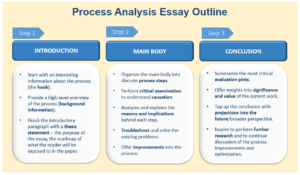How to Write a Process Analysis Essay?
Nov 16, 2023

Process analysis is a task that can catch you by surprise. In fact, many students often confuse it with another popular assignment – process description.
This article has everything you may ever need to perform a perfect process analysis. It can take you from zero knowledge about this type of work to a pro-level in almost no time!
Despite the clear guidelines and tips provided for writing a process analysis essay, the complexity of the task can sometimes lead students to think, ‘I wish someone could just do my essay for me.’ This sentiment often arises from the pressure to dissect a process meticulously and present it coherently and well-structured. While it’s understandable to seek help navigating these challenges, relying on someone else to ‘do my essay’ means missing out on the opportunity to develop crucial analytical and writing skills. It’s important to remember that the process of crafting a process analysis essay is as valuable as the end product, teaching you not just about the subject matter but also about organizing thoughts and conveying complex ideas effectively.
What is a Process Analysis Essay?
A process analysis essay is a stand-alone academic assignment that aims to describe how things work. It does it meticulously, step-by-step, in a clear manner, and with a formal tone of voice.
In essence, an essay analyzing a process is a type of expository essay, as it exposes the reader to the details of how something works, what it is made of, how individual parts are linked together to produce the outcome, and whether they enhance (synergy), complement, or contrast each other.
This is where a process analysis often gets confused with a process description. In simple terms, the description only explains how things work, while analysis sees deeper into the underlying principles of things, their reasons, and implications. Check out the following table for further details:
| Aspect | Process Analysis |
Process Description |
| Focus | To analyze and explain the reasons and implications behind each step of a process. | To describe the steps involved in a process. |
| Purpose | To deepen the reader’s understanding of the process by providing insights into the “why” of each step. | To inform the reader about the exact sequence of steps in a process. |
| Detail Level | In-depth examination, often addressing causation, decision-making, and problem-solving. | A high-level account of the steps, focusing on what happens at each stage. |
| Examples | “The Strategic Thinking Process: How Leaders Make Informed Decisions.” | “The Process of Brewing an Ideal Cup of Espresso at Home.” |
Keep in mind, that even the best process analysis essay examples are not necessarily complex and academically sophisticated. Furthermore, just by looking at the title one cannot say if it’s a process description or a process analysis paper, as a seemingly simple title can hide a complex analysis inside, and vice versa, a long and sophisticated title may contain nothing more than a straightforward description of a simple process.
Process Analysis Essay Outline
The word “essay” in this assignment sets specific expectations for the literary composition. When writing a process analysis essay, one has to follow a defined structure, consisting of an introductory part, the main part, and a conclusion. The essay genre also requires the inclusion of a captivating ‘hook’ and a clear thesis statement in the introduction.
For more information, check out this process analysis essay sample outline:

How to Start a Process Analysis Essay
Starting this type of essay is the art of balancing content and impression. The content (volume) and impression (quality) of information that you give at the start have to be just right to ignite the reader’s appetite but not to satiate them.
Similar to how a good meal in an expensive restaurant starts with an appetizer and a menu, in our writing business, an introductory part should capture attention and provide a roadmap (menu) for the content ahead.
|
Step # |
Description |
Examples |
| Step 1. Begin with a reason | “Hook” your reader with an important reason to continue reading, providing a glimpse at the purpose of the paper. |
|
| Step 2. Add a little bit more context | To enable your reader to see a bigger picture and to understand the purpose better. |
|
| Step 3. Finish with a thesis statement | A thesis statement is the reader’s menu – what to expect to see in paper |
|
How to Pick Up and Analyze a Process
The general guideline is to pick a process that you know well and can analyze and describe with passion and detail.
Consider the following categories of processes to find what might interest you:
Technical process:
- The process of assembling a piece of furniture;
- Installing software on a PC;
Cooking and food serving processes:
- Steps in making homemade cookies;
- Brewing a perfect cup of coffee;
Educational and academic processes:
- Steps for mastering the German language;
- Navigating the university application process.
Business and management processes:
- How to write and implement a business plan;
- Steps for running a successful workshop;
Everyday & life processes:
- How to plan the most amazing trip;
- How to manage stress and wellbeing.
To analyze a chosen process, perform a critical examination, understand causation, and employ problem-solving and decision-making:
- Critical examination. Critical analysis of the steps involved, evaluating their strengths and weaknesses, as well as discussing alternatives or variations within the process.
- Understanding causation. You’ll need to explore cause-and-effect relationships between the steps of a process.
- Decision-making and problem-solving – you may need to perform a troubleshooting of a process to identify and solve the existing problems with the end goal of optimizing the process.
You may want to consider organizing your analyses into separate paragraphs. Each process analysis paragraph should be devoted to a separate step in the process. Any process analysis ideas (improvements and optimizations) you may have should fit into appropriate steps with relevant paragraphs.
The Do’s and Don’ts of Writing a Process Analysis
As you delve into writing a process analysis, remember to periodically check the following Do’s and Don’ts:
| Do’s | Don’ts |
| ✅ Analyze and explain the reasons and implications behind each step | 🚫 Describe and inform without examination and evaluation |
| ✅ Select an inspiring process that you thoroughly understand | 🚫 Pick a simple process to describe |
| ✅ Begin writing with a “hook” and give a little bit of background | 🚫 Use vague and incoherent process description |
| ✅ Add a clear thesis statement | 🚫 Use an informal and first-person tone of voice |
| ✅ Perform critical examination and understand the causation of each step | 🚫 Add any new information into the process essay conclusion |
Closing Notes
Analyzing a process can be a captivating type of work. It helps to develop the necessary analytical and critical thinking skills and to prepare us for whatever academic or professional challenges we may face. With the help of the current article, you’d be able to craft perfect process analysis and always qualify for and aspire to the highest grades and assessment of your work.

Time is precious
don’t waste it!
Get instant essay
writing help!






